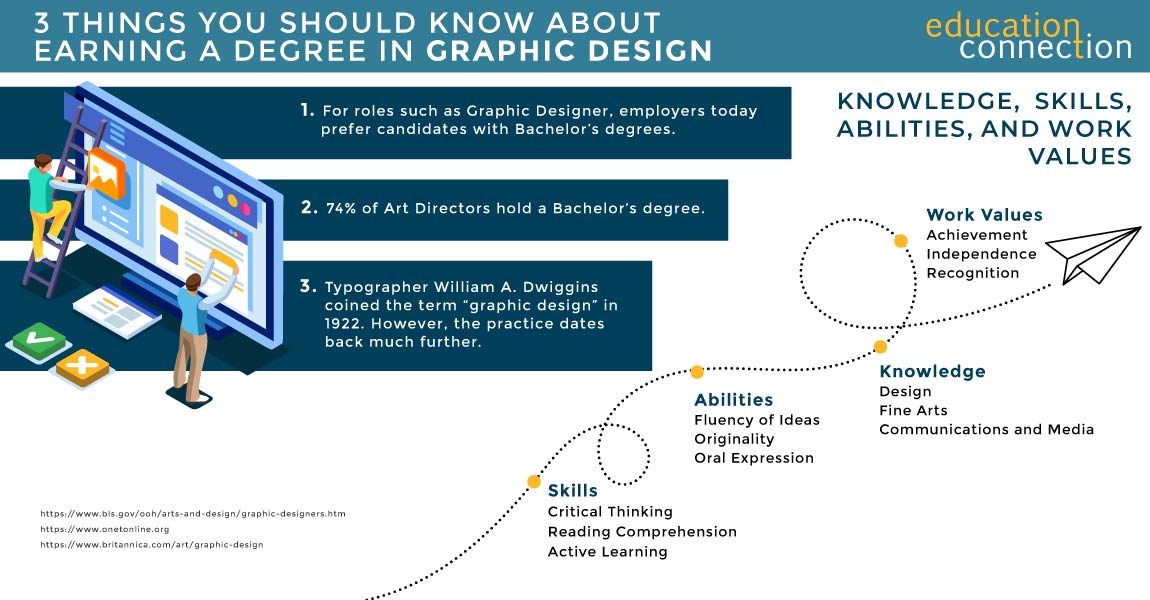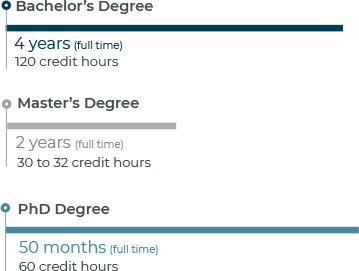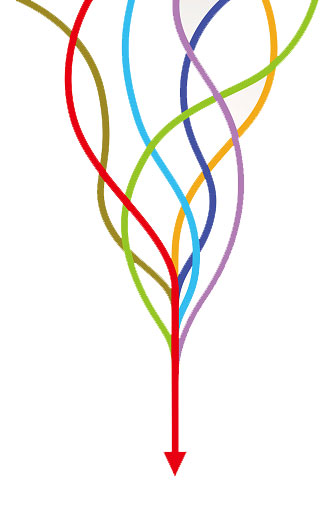What is an Online Graphic Design Degree?
Online students study the theories and skills needed in the graphic communication industry. From industry standards to the know how needed to create visuals for consumer materials. That may include everything from advertisements and brochures. To photoshop and computer graphic arts for web development.
As a graphic design student, you are likely to start with the principles of design. Such as color theory and typography. You also typically study the software and tools used to create designs. This may include some of the main concepts of marketing communications. Like how to reach a group through images. Some programs also cover digital media and areas of interest for aspiring multimedia animators. Finally, while going for online education, you may create a professional digital portfolio of design work. Are you creative? Do you want to help companies communicate in a visual way? Then, this field may interest you.

TYPES OF GRAPHIC DESIGN DEGREE PROGRAMS
Graphic Design Associate’s (Web and Interactive Design Focus)
In this program, you may pursue foundational knowledge of graphic design. You may gain skills and learn about technology. You might also cover multimedia design, traditional art, and more. These areas tend to help people new to the field learn critical thinking skills as well as design basics.
Course Examples:
- Design Foundations
- 3D Animation
- User Experience Design
B.A. in Graphic Design and Media Arts
Here, you may focus on turning concepts into design, from print to web. You may learn the theories and technologies behind creating designs. And, you may choose a concentration in Web Design or 3D Modeling and Animation.
Course Examples:
- Basic Design and Color Theory
- Advanced Digital Imaging
- Digital Graphic Design for the Web
M.F.A. in Graphic Design and Visual Experience
In this M.F.A program, you may explore advanced topics. It is designed to broaden your perceptions. You will study everything from ideation models to multimedia artist skills. And, you will engage in graduate research and discovery.
Course Examples:
- Visual Analysis of Static Content
- Visual Design for Interactive Contexts
Online Graphic Design Degree Programs
There may be degrees in graphic design at both the undergraduate and graduate levels. What do these programs cover? Programs at all levels typically combine artistic and technical concepts. As a result, you may take online courses in many areas. From the skills needed to lay out pages in a magazine to editing digital images for the web. Also, areas that help plan out well designed visuals and packaging design. Along the way, you may flex your creative muscles as you work on your own design capstone projects. This may grow the problem solving skills needed for a range of graphic design careers.
Associate’s in Graphic Design Online Programs
At the Associate’s level, you may explore the basics of visual communications. This means you will cover topics such as typography (the art of type), image editing, and website design. You can expect to explore commonly used graphic design software, like Adobe Creative Cloud. And, you will gain a greater appreciation of art and design, whether you find it in museums, video games, social media or on billboards!
Associate’s programs may include:
- An Associate of Arts (A.A.) in Graphic Design
- Associate of Science (A.S.) in Graphic Design
- Graphic Design Associate of Applied Science (A.A.S.)
All programs, you will find, share similarities. But, A.A. and A.S. programs are often best for you if you transfer to a four year school, later. And, while many programs involve your creativity and the arts, an A.A. program may require you to take more liberal arts electives. In an A.S. program, you may encounter more math or technology electives.
Online Bachelor’s in Graphic Design Programs
In an online Bachelor’s degree program you may expect a ground up approach. You might take foundational art courses, like drawing and color theory. Also, you may study the history of graphic design and how the discipline evolved.
You will also explore different applications for design. This could include a range of industries. Your graphic design skills can be used for branding, advertising, publishing, and more! You could try your hand at everything from print design to creating software user interfaces that are easy on the eyes.
Your technical skills will play a big role in most programs. After all, much of your design will be for digital, from websites to apps. So, you can expect to study software and related skill areas. These could include photo editing programs to HTML.
Bachelor’s programs may include:
- Bachelor of Arts (B.A.) in Graphic Design and Media Arts
- Graphic Design Bachelor of Fine Arts (B.F.A.)
- Bachelor of Science (B.S.) in Graphic Design
Earning a B.A. or B.S. in Graphic Design may offer you a broader exploration of the liberal arts and sciences. You could pursue diverse knowledge areas besides graphic design, for instance. And, you could prepare for potential graduate study. A B.F.A. is a professional degree. It may feature more career oriented coursework. For instance, you could study brand identity, environmental design, and even 3D animation. However, you may not take as many electives outside your major.
Finally, some programs offer you concentrations, as well. These could include:
- Web Design
- Interactive Design
- Animation and Motion Graphics
- 3D Design
- And others
Online Master’s in Graphic Design Programs
In a master’s program, you may build on what you learned in an undergraduate program. And, you could potentially update your technology knowledge. As you can imagine, the graphic design field is highly technical. It changes fast.
If you complete a Master’s program, you may delve deeper into design theory. You could take a critical approach to movements and trends in the field. Also, you could take advanced course work in areas such as interactive design and typography. You could even study graphic design research.
Master’s in Graphic Design may include:
- Master of Arts (M.A.) in Graphic Design
- Master of Fine Arts (M.F.A.) in Graphic Design
You will find that these programs may have overlapping coursework. If you choose an M.A., you may be more focused on theory and research. But, an M.FA. may have you hone in more on the practice of design.
1
Southern New Hampshire University
- Take advantage of some of the nation’s most affordable tuition rates, while earning a degree from a private, nonprofit, NEASC accredited university
- Qualified students with 2.5 GPA and up may receive up to $20K in grants & scholarships
- Multiple term start dates throughout the year. 24/7 online classroom access.
Popular Programs
Business Administration, Psychology, Information Technology, Human Services…
2
University of Arizona Global Campus
- 99% of University of Arizona Global Campus students study online
- University of Arizona Global Campus offers affordable tuition, so college is accessible to many students.
- he University of Arizona Global Campus (formerly Ashford University) is accredited by WASC Senior College and University Commission (WSCUC)
Available Programs
Accounting and Finance, Information Technology, Political Science…
3
Western Governors University
- Award-winning programs created to help you succeed.
- A quality education doesn’t have to be expensive. Earn an accredited degree for less.
- Programs start monthly – Apply free this week!
Sponsored Schools
Graphic Design Degree Program Core Courses
What kind of graphic design courses could you take? Whether at the Associate’s, Bachelor’s, or Master’s level, you will take classes that explore the theory of art and design. You will also study technical subjects. These might include everything from digital image editing to package design and animation.
Here are a few common courses you may find in your prospective program:
History of Graphic Design: The earliest examples of graphic design were pictographs found in caves! In a course like this, you’ll learn the key figures, innovations, and tech tools that shaped the industry as we know it today.
Web Design: Design for web calls for knowledge of how to make websites user friendly and visually pleasing. That’s true whether they’re viewed on a computer screen or mobile device. This course covers the principles of website design, along with skill areas like CSS.
Typography: You’ll likely take one or more courses exploring the art of the font. Expect to learn how type is designed and how to use it to communicate with your audience. And, you could work on projects that use type in different ways.
Electronic Publishing: Sometimes, designers work on publications that are many pages long. This course teaches you how to design large documents, from ebooks to magazines. You may study everything from choosing colors to working with master pages in Adobe InDesign.
How Long Does It Take You to Earn a Degree in Graphic Design?
Earning an Associate’s degree in graphic design may take you around two years. Earning a Bachelor’s degree could take you around four years. Master’s programs vary in length, but could take you about two years. Remember that your degree length also depends on whether you study part time or full time.

Graphic Design Degrees Program Examples
| School | Degree Level | # of Credits Required | Start Dates | Minimum Months to Complete |
| Rasmussen College | Associate’s | 91 | Multiple | 18 months |
| Full Sail University | Bachelor’s | 120 | 5 per year | 29 months |
| Grand Canyon University | Bachelor’s | 120 | Multiple | 29 months |
Top Schools Offering Graphic Design Programs
NCES names 656 institutions where one may study graphic design. From those schools, you will find 8,931 degrees were awarded to students in 2022 (the most recent data). Most of these degrees, you will see, were at the B.A. or B.F.A. level.
| School | 2022 Degrees awarded | 2023/24 Tuition (out of state unless *) |
| School of Visual Arts | 219 | $49,140* |
| Full Sail University | 201 | $26,417 |
| Southern New Hampshire University | 521 | $16,450 |
| California State Polytechnic University Pomona | 105 | $19,319 |
| Maryland Institute College of Art | 95 | $55,150 |
| Columbia College Chicago | 76 | $32,520* |
| Pratt Institute Main | 67 | $59,683 |
| Ferris State University | 43 | $13,630* |
Choosing an Accredited Graphic Design Program
When looking into graphic design schools, you might also request info about accreditation. Regionally accredited schools may take part in state and federal financial aid. These schools may also help you transfer credit hours from one to the next.
Some schools also go an extra step and seek accreditation for certain programs. The main accreditor is the National Association of Schools of Art and Design (NASAD). NASAD accredits over 360 institutions with arts and design programs. Programs must meet NASAD’s rigorous quality standards. These standards emphasize areas like:
- Artistic and educational fundamentals
- Faculty qualifications and specializations
- Resources, such as studio space and technology
- Connections to the design community
- Connections to the local community
If you graduate from an accredited program, it could help you make sure that what you learned meets the expectations in your industry. But, it’s not necessarily a requirement for pursuing a design career path.





